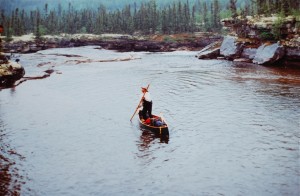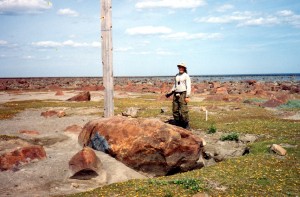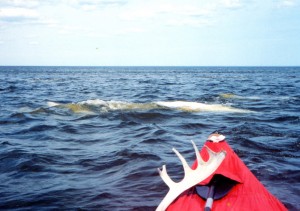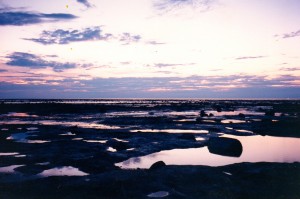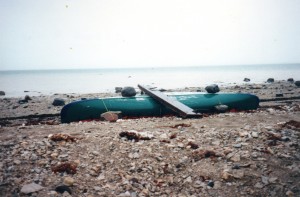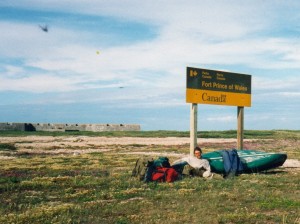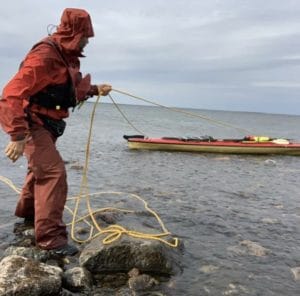Fair warning: what I’m talking about today has absolutely nothing to do with martial arts training. But – in keeping with a previous theme – it has everything to do with deliberately facing self-imposed challenges, whatever they may be. This article is really a continuation of a previous one discussing why martial arts training provides some of the few ‘real’ rites of passage in today’s society (click here for that article, entitled Bood, Sweat and… Sparta!!! ).
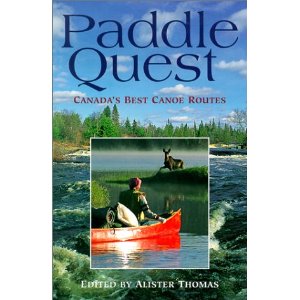 In that post I touched on an 82 day solo canoe trip which – for me – had served as a coming of age ritual of sorts.
In that post I touched on an 82 day solo canoe trip which – for me – had served as a coming of age ritual of sorts.
When I finally got back to civilization I contributed a piece about the last three days of that trip for a book called Paddle Quest: Canada’s Best Canoe Routes.
Here, with the kind permission of Allister Thomas, the editor of the book, is the story of one of the most formative experiences of my entire life.
Hudson Bay, from the Seal River to Churchill
A map library is a dangerous place to be if you have the urge to jump into your canoe and go for a paddle. It only took one September afternoon in the University of Toronto map library to connect enough lakes, streams and rivers to get from Jasper, Alberta in the Rocky Mountains to the coast of Hudson Bay. This was a trip that would take me halfway across Canada, most of it far beyond the reach of roads and civilization. It took another eight months of preparation and almost three months of paddling to complete this trip of a lifetime.
From the beginning I knew that this would be a solo trip. All my paddling partners were firmly entrenched in their jobs or studies, so a three-month trip was out of the question for them. Partners would have made the going easier and safer, but I was going to have to rely on meticulous planning and cautious canoeing to provide a safety net. As my friend, longtime arctic trekker Gino Bergeron, once told me: “it’s okay to go on a solo trip, but you need to make sure that you always stay at least one notch below your limits.”
The Athabasca, Fond du Lac, Cochrane and Seal rivers carried me 2,700 kilometers across Canada. I paddled down rivers, ran rapids and sailed across lakes. I poled, lined and portaged my way up rivers. I struggled to find old portages or bush-crashed my way to create new ones. It was a beautiful, and at times deeply challenging, journey.
But it was the last 60 kilometers – from the Seal River delta along the coast of Hudson Bay to Churchill, Manitoba – that caused me the most hardship. And I feel that there is a real danger to glorifying canoeing on Hudson Bay – this was the only part of the trip that I would hesitate to repeat on my own, or recommending to other paddlers.
The threat of sudden storms, extremely swift tides, and the ever-present threat of polar bears should not be underestimated: Hudson Bay is the most potentially dangerous and unforgiving body of water that I have ever paddled. It was also beautiful, unforgettable and, in retrospect, the perfect ending to my journey.
As the Seal River spills into the cold waters of Hudson Bay it divides into a huge delta – islands and channels form such a complex mosaic that even with a compass and a detailed 1:50:000 topographic map you soon give up trying to keep track of your exact position.
Most river deltas deliver a slow and tired waterway to its final resting place in a lake or ocean; not so with the Seal. This delta seethes and churns with whitewater all along its 15-kilometer length. Needless to say I was pretty focused on navigating the continuous rapids, but after several hours of careful maneuvering in the delta I was finally able to spot the vast expanse of Hudson Bay. Finally, at the base of an enormous wave train, I was able to taste oceanic salt in the water.
I pulled my 16-foot Kevlar Prospector through the intertidal mud, and climbed the low promontory where paddlers typically meet their pick-up boats from Churchill. There was, however, no boat waiting for me. The trip had been so long, and involved so many variables, that I hadn’t wanted to commit to a specific pick-up date.
An option that had crossed my mind was wait at the mouth of the river and try to hitch a ride to Churchill on a chartered pick-up boat when one came – as it surely would – to get another group of paddlers. In fact I’d just met two such groups with scheduled boat rides in the last few days. Things were getting a bit busy on the tundra, as one of these groups consisted of 18 teenagers and two adults.
Although they were willing to give me a lift I was hesitant to take advantage of their offers. I love canoeing with people, but when it really came down to it, I didn’t want to spend the last days of a spectacular solo trip in the company of any group. My plan, for better or worse, was to paddle the Bay itself.
Instead I filled all available containers with fresh river water, checked my EPIRB (Emergency Position Indicator Radio Beacon) and tide table, bucked down my spray deck and took paddle in hand once more. It is difficult to explain now, but at the time there was a feeling of doing the right thing. An acute awareness – almost a hypersensitivity – of the wind and waves came over me. This red-alert mode stayed with me the entire time that I was on that windswept and tide-torn coast.
Beluga Whales
I pulled away from shore, looking for the deeper navigable waters that lie beyond the tidal flats, and my heart sank when I saw whitecaps on the waves. Looking more closely, however, I realized that the whitecaps were the white backs of surfacing beluga whales. In a matter of minutes I was in the middle of a pod, and it seemed like there were hundreds of these great mammals all around my fragile craft.
I was transfixed by the sights and the sounds. There were squeaks, moans, whispers and hundreds of other whale noises. Once I swung around in my seat, trying to locate the crying baby I had just heard, only to realize that the keening had come from a beluga only 3 meters behind me. Although full of respect for the power of these magnificent creatures, I never felt that I was in danger; they never came close to touching me.
This dance continued for a while as I paddled south along the coast. As I finally paddled away from the beluga pod I felt I had made the right decision venturing onto the waters of the Bay. Even if I was stormbound for a week, paddling with the whales would have made it worthwhile.
Late that evening, about 10:00, I decided to get some rest. Unfortunately the tide had gone out so far that making it all the way to shore was impossible (the tidal flats are up to 5 km wide in this part of the Bay). “Camp,” therefore, was established on a small elevated mud plateau in the intertidal zone, about 2 kilometers from the actual shore. I dozed fitfully for a few hours, not wanting to sleep too deeply for fear of polar bears and the returning tide.
At this latitude the sun rises at about 3:00 AM during the summer months, and as it rose I started dragging and portaging my gear back across the flats, towards the approaching tide. With the wind so calm I wasn’t content to stay put and wait for the water to come to me; I wanted to get in as many hours of paddling as possible before the afternoon winds picked up.
It was hard work and I soon became absolutely ruthless, using my canoe as a sled for my gear and dragging it through puddles barely deep enough to cover the toes of my boots.
Eventually I was afloat again, and in the early hours of July 22nd I paddled past the Knife River Delta. I was now about halfway to Churchill. But in order to find water deep enough to paddle in I had to be far offshore. The low relief of the land and its tundra vegetation meant that shore was barely visible, often just a thin line on my right-hand horizon. In order to go the right way (south) I had to follow compass bearings while trying to compensate for the effect of tide and wind. The consequences of getting washed out to sea by the 5-meter tide was constantly on my mind.
To avoid the steadily rising offshore winds I decided to make camp in the early evening. The site was on a sandbar parallel to the coast. The presence of plants and a high waterline were reassuring: they told me that it was unlikely that I would be washed away during the night. While eating dinner I studied the far-off grain elevators of Churchill, thinking and strategizing about the best way to negotiate the waters of the Bay the next day.
Suspicious clouds in the distance convinced me to use boulders from the tidal flats as anchors to secure my tent, and I also piled boulders and driftwood into my canoe to stop it from blowing away (which had come close to happening during windstorms on previous trips).
That night, despite the ferocity of a tundra rainstorm, I fell into a most delicious sleep. The adrenaline had finally worn off, after 32 hours of almost continuous paddling and traveling.
Offshore Tide
During the third and final day of paddling, I decided for the first time to try and paddle with an offshore tide. To be safe, I stayed between the shore and the last exposed boulders of the intertidal zone. If the tidal current overpowered me and started washing me out to sea, my plan was to paddle over to one of the tiny rock islands and hang on for dear life until the tide subsided.
I also resisted the temptation to leave the shore and cut across the final large bay between myself and Churchill. Although that shortcut might have saved me about 10 kilometers of paddling, I had heard too many horror stories about storms coming in as paddlers set off to cross the expanse of Button Bay. No, better to take a bit of extra time and hug the shore. I didn’t want to have an accident now, not so close to the goal.
But hugging the shore had its own inherent difficulties. The huge tide and the speed of the current heading out to sea made it necessary to set the canoe at an angle and ferry across the offshore current, just as if I was crossing a river. And then there were times that the water was so shallow that it was easier to use the paddle as a pole, shoving myself along the sand and gravel seabed.
Fort Prince of Wales, and Churchill
Just as my arms were about to fall off, I reached the base of the thin peninsula separating me from the outflow of the Churchill River and the port of Churchill.
The 2-kilometer portage across the base of the peninsula was easy when compared to the prospect of having to paddle around the tip in ever-more-turbulent seas.
And the portage even went right past Fort Prince of Wales, built in the 1730′s to guard the northerly territory of the Hudson Bay Company against the French! The gates were open and I got to explore the fort on my own for an hour or so.
As I prepared my final dinner of the trip and waited for the winds to die down enough to cross the wide Churchill River, I reflected on the past months and realized that arriving at my goal was creating conflicting and discordant feelings.
On the one hand, I was elated at having arrived; the grail was within my grasp, and the goal I had striven for in eight months of planning and paddling was finally before me. On the other, I knew this was the end of a certain simplicity, wherein life had come to consist of sleeping, eating, setting up camp and paddling. The act of living and traveling in the bush had become ‘normal’ to me; I only had a few hours left and I knew I would miss it.
Nonetheless, I was ready for ice cream, warm showers, music and the train ride taking me south. I wanted to see the photos on my 15 rolls of film, and I wanted to spend time with friends and family. I also felt slightly guilty about wanting these things, so seemingly antithetical to the whole experience of the summer.
On the three-day train ride from Churchill to Toronto I stared making peace between these conflicting feelings. I mourned the end of the adventure, but nothing could take away or diminish my memories.
And because I still had two weeks of food left in my bags, every time the train crossed yet another mysterious and inviting river, I wanted to stop, get off, and start all over again.
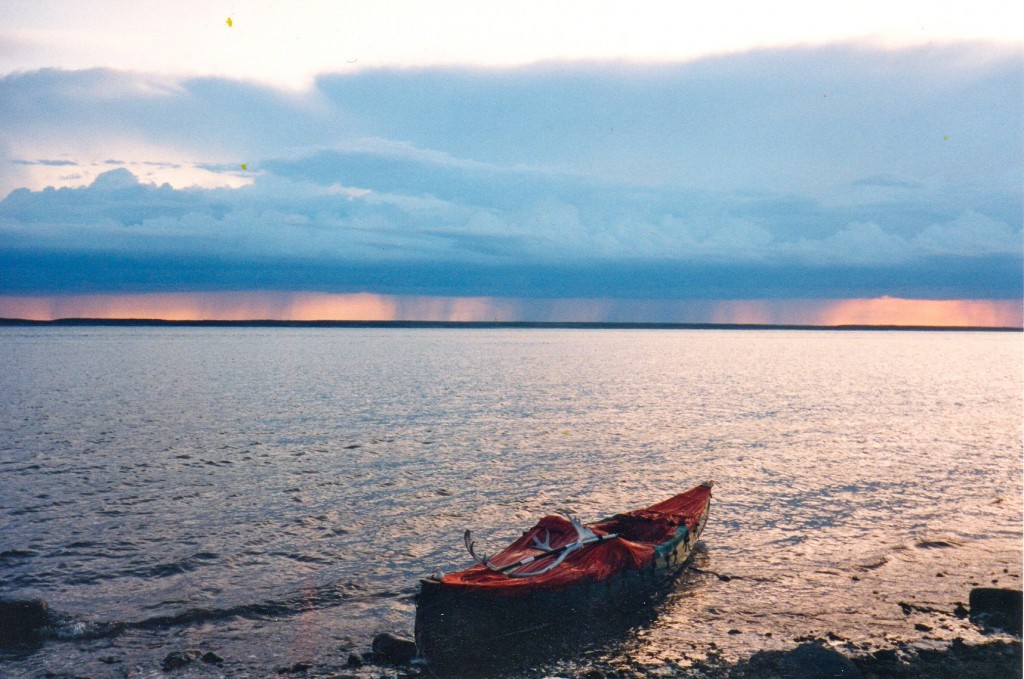
P.S. If you liked this article then check out another trip I did, many years later, that I call the Thousand Mile Solo.
That 42 day solo trip in 2019 took me down the Churchill River, up the Reindeer River, across Reindeer Lake, up the Cochrane River, across Nueltin Lake, and down the little-travelled Thlewiaza River to Arviat on Hudson Bay.
It’s a good read I think!
The post Belugas, Bears and an Offshore Tide on Hudson Bay appeared first on Grapplearts.

